 Sperm whales, killer whales and dolphins
can be spotted just a few miles off the coast of the French island
Guadeloupe. This morning we've come across a twelve metre long
sperm whale. I slide into the water and swim towards him hoping
he doesn't dive... Sperm whales, killer whales and dolphins
can be spotted just a few miles off the coast of the French island
Guadeloupe. This morning we've come across a twelve metre long
sperm whale. I slide into the water and swim towards him hoping
he doesn't dive...
-
- Text and photogaphy by Jean-François
Vibert - Translation
: barnaby.apps@wanadoo.fr
-
- All of a sudden the huge dark
shape appears fifty metres in front of me. My heart beat races
and I run out of breath as I swim towards it. Underneath, a thousand
metres of the purest blue sea make me feel as though I'm the
size of an insect. Suddenly the cetacian changes direction and
swims towards me. My efforts in the water become pointless.
-
-
-
- The voice of Renato Rinaldi,
the whale specialist who first got me into this adventure rings
in my ears : "Don't try and get close to the animal, he
will come to you if it wants to". And that's exactly what
happens:The twelve metres long young bull starts swiming towards
me.
-
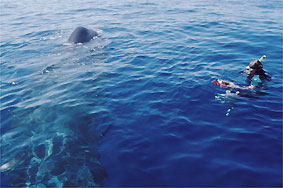 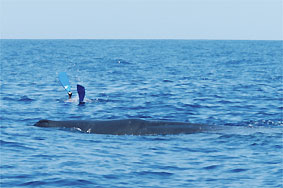
- I can bearly
comprehend what 's happening. I think I'm too close and start
swiming backwards
|
- After a few
minutess I manage to control my breathing... and decide to go
and see what he looks like from underneath.
|
-
- Thirty metres, twenty metres,
ten metres ,whales swim fast. My God, he's coming for me !
-
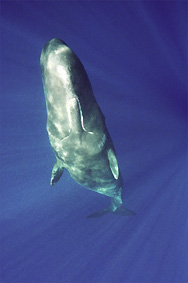 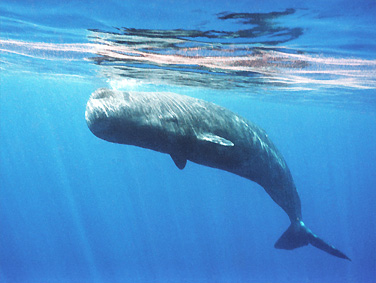
- Suddenly he
swims up, his jaw rotating round towards me. What's he going
to do?
|
- The huge bulk
moves with effortless grace. Never the less he's fast, with one
bearly detectable movement he goes much faster than me when I
swim as hard as I can.
|
-
- I don't know what to do. I stay
still. He's swiming towards me. At last he stops. Only two small
metres separate me from his thirty tone bulk. Anything could
happen now. All of a sudden loud and powerful clicking noises
ring in my ears, this I know to be his sonar system capable of
reaching tens of kilometres away. Maybe he is saying hello in
whale. I don't know how to answer back. I trigger the flash light
on my under water camera, which makes three loud beeps.Luckily
for me,and to my great relief, the most formidable preditor alive
today doesn't seem to mind flash lights.
 Listen
to the spermwhale Listen
to the spermwhale
-
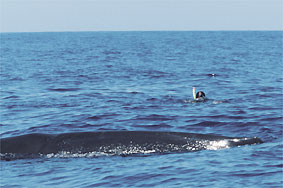 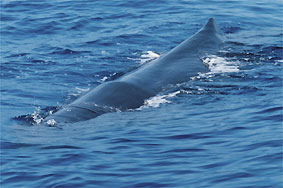
- It's very frustrating
not to be able to use oxigen cylinders at such a time...
|
- Only the front
part of the animal (the dorsal hump) is visable on the surface.
|
-
- I'm not scared but my legs feel
weak. The evening before I read that, although we know whales
usually feed on giant skquids they hunt up to a thousand metres
down, once, a two metres long shark was found whole in the stomack
of one of these creatures. Come on now ! As long as you don't
annoy them , whales won't attack divers. We are no longer in
the days when whales sold their lives dearly because hunted,
sending their aggressors down to Davy jones' locker. I can't
help thinking about one of my childhood books, the cover of which
represented a bashed up whaling boat destroyed by a famous white
sperm whale ; Moby Dick .
-
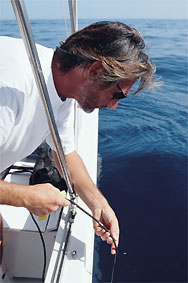 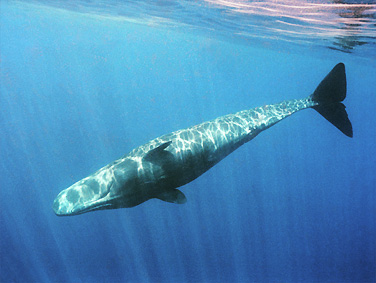
- The principle
is to move around untill you get the best echo with the hydrophone.
Then you wait for the whale to surface and spurt.
|
- When I dive
tens of metres down to take a picture of him from underneath...he
decides to follow me!...I come up out of breath...and he surfaces
too, probably a little frustrated not to have had the chance
to show me his home !
|
-
- "Carefull Jeff , you're
too near, get back ! "Over on the speed boat, Rénato
is waving, I remember his safety instructions. "If he blows
bubbles or opens his jaw it means he's angry, in which case get
back to the boat quick because we don't know how he might react
".That 's why people don't dive with cylinders when they
want to get near whales, whales hate bubbles, it's probably a
sign of agression for them. "They can also have their crazy
moments," he explaned. "Once a huge bull wanted to
put his head on the back of my boat. Forty tonnes worth of whale.
I very nearly capsized."
-
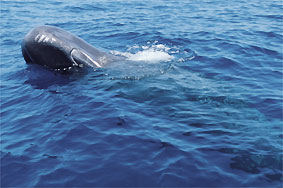 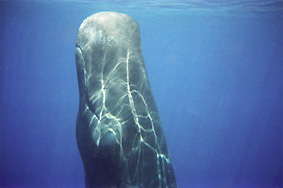
- Mobydick swiming
on his stomach...or on his back! Inableing us to see all the
length of his jaw. nage sur le ventre... ou sur le dos !
|
- A classic whale
attitude : They stick their heads out of the water virtically
so they can see what's going on !
|
-
- I swim away from him, I have
to, he dosen't fit in the frame. No bubbles, no jaw movements,
everything seems fine...He's got his eye on me. I try to swim
round him, he turns his head to face me. I take a deep breath
and dive ten metres down to take a picture from underneath. Surprise:
he too sinks down, as if he had decided to acompany me to the
abyss to hunt giant skquid !
-
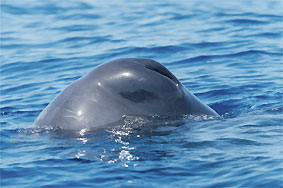 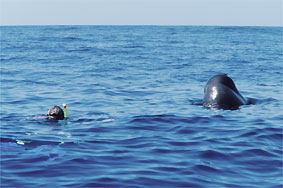
- Whales have
only one vent to breath from which is situated on the left of
their heads.
|
- From a couple
of metres away I can feel the air spurting out of his vent :
a very fishy smell !
|
-
- Amazing: he is circling me.
He dives, swims on his back underneath me creating a noticeable
swirl. Looking down just below my flippers I see his two metre
long jaw, then his belly swims past, I then find myself starring
at his gigantic fin, one whip of which, could kill me instantly.
I take another deep breath and the underwater ballet continues.
Looking confident, the whale swims nearer and nearer. Suddenly
I hear Renato, obviously nervous, starting up the engine. I feel
quite safe, dare I say: in harmony with my new found friend.
-
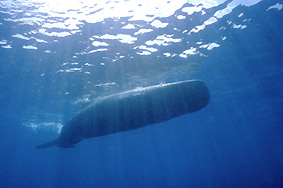 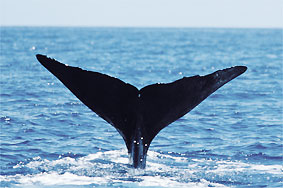
- Seen from underneath
the sperm whale with it's enormous square head resembles a nuclear
submarine.
|
- A farewell flick
of his tail before diving. He will surface again in 40 minutes.
|
-
- Because my camera has run out
of film I swim to the boat to reload. Renato helps me on board.
To my great surprise he tells me I've been in the water for twenty
seven minutes. What I've just been through hits me and I suddenly
feel exhausted and have great dificulty reloading my camera.
All the while my new found friend is swiming out to sea, alerted,
maybe, by the song of a mate. He seems to have decided to leave
us, and there is little point in trying to follow him. Before
diving he gives us a final flick of his tail as a fearwell present.
-
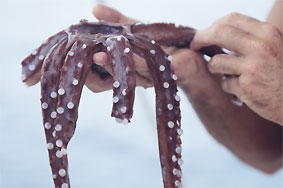 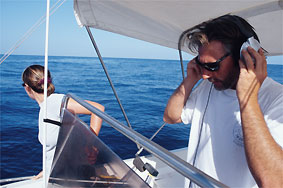
- This looks like
the remains of a Sperm whale's diner : a sample of skquid found
floating at the surface of the ocean.
|
- Renato Rinaldi
uses a hydrophone to listen to and tape the whale's song.
|
-
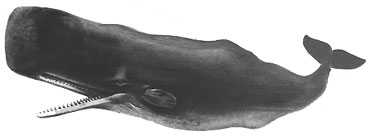  Whasa
sperm whale ? Whasa
sperm whale ?
A Sperm whale is a mammal in other words a cetacean. Cetaceans
are classified as two distinct types : Odontoceteas which have
teeth (sperm whales, belugas, killer whales, dolphins, porpoise)
and mysticete whales which are equiped with whalebone to filter
plankton and small fish.
-
- Bulls can weigh up to 57 tonnes
and measure up to 18 metres in length. They have 18 to 25 teeth,
can dive for 45 minutes and in between dives can rest at the
surface for a few minutes up to an hour. They hold the world
record for deep sea diving : scientists have registered whales
at depths of 2250 m ! They can be found in all the seas around
the world and are no longer in danger of extinction as whaling
was made illeagal in1982.
-
- Whales find each other and comunicate
thanks to their sonar system : A loud powerfull clicking sound
on a wide range of frequencies. It is only by using hydrophones
that we are able to detect and approach whales. All we have to
do then is wait for them to surface to breath and look out for
their spurts which are sometimes visible from great distances.
-
 Listen
to the spermwhale Listen
to the spermwhale
-
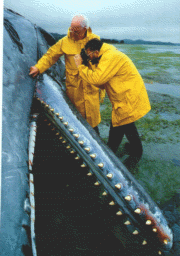 
 The clash of the titans in the abyss The clash of the titans in the abyss
-
- The photo on
the left shows the impressive jaw of a sperm whale on which was
found the caracteristic traces of a giant squids giant tenticles.
The estimated length of the cephalopod given the diametre of
it's suction pads is 25 metres. Having said that, the whale's
jaw isn't exactly small !
-
- On the right
an authentic specimen of an Achiteuthis of average size but in
perfect condition.
-
- Photo credit
: unknown
|
 Sperm whales eats giant squeeds ! Sperm whales eats giant squeeds !
-
 And
why do whales dive so deep ? To feed on their favourite food,
giant squid (Architeuthis Dux). Traces of giant tenticles have
been found on some Sperm Whales which have led some scientists
to believe that some specimens living in the abyss can be tens
of meters in length. And
why do whales dive so deep ? To feed on their favourite food,
giant squid (Architeuthis Dux). Traces of giant tenticles have
been found on some Sperm Whales which have led some scientists
to believe that some specimens living in the abyss can be tens
of meters in length.
-
- Whalers would often find bits
of tentacles several metres long in the stomachs of their catch.
Few scientists, though, are sure about the existence of giant
skquids because it's so rare to find one in good condition. There
are, neverthless, many clues that would suggest they do exist
although generally all we see of them are shapeless heaps of
washed up flesh on beaches after storms (like the monster of
Florida photographed in 1897).
-
 Divers
should be reasured, for they havn't a chance of ever coming face
to face with one of these monsters because of the deepth in which
they live. Down 1000 or 2000 metres, the abyss is as dark as
can be, temperatures are just above"0"and the pressure
is collossal, (this might explain why they are so rarely washed
up on shore : their invertibrated bodies don't stand up to the
change in pressure when they surface). Visit here the site of an American expidition
which tried (but failed) to film Architeuthis in 1999. Divers
should be reasured, for they havn't a chance of ever coming face
to face with one of these monsters because of the deepth in which
they live. Down 1000 or 2000 metres, the abyss is as dark as
can be, temperatures are just above"0"and the pressure
is collossal, (this might explain why they are so rarely washed
up on shore : their invertibrated bodies don't stand up to the
change in pressure when they surface). Visit here the site of an American expidition
which tried (but failed) to film Architeuthis in 1999.
-
- I've also collected on this page
links on giant skquids and some amazing photos found on the net.
|
-
 You can go whale watching in Guadeloupe You can go whale watching in Guadeloupe
-
- You can watch Sperm whales,
hunchbacks, dolphins 5to 10 miles out between november and may
on board the Catadive, globicéphale tropical, dauphin
tacheté pantropical ou orque naine.
-
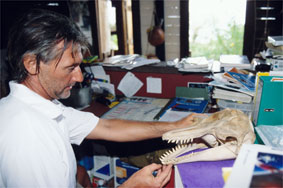 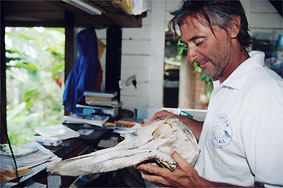
- Renato in his
home near Bouillante. Built in the forest his whole house is
dedecated to his passion for cetacean.
|
- In the photo
on the right he is holding the skull of a small killer whale
and on the left the skull of a dolphin.
|
-
- Organisations that protect whales
have granted a charter that stipulates how vessels should approach
the animals so as not to bother them. In this maner people can
watch the whales from a distence of about twenty metres. Obviously
it is forbidden to get into the water (scientists and proffesional
photogaphers are the only ones allowed to do that).
-
- With the aid of a hydrophone
and various teaching aids, you will be able to listen to the
song and clicking of the whales. A half day out whale watching
costs 120 to 240 f .
 Centre de plongée Les
heures saines Réserve Cousteau Centre de plongée Les
heures saines Réserve Cousteau
Le Rocher de Malendure Pigeon. 97132 Bouillante
Guadeloupe
Tél. 0590.98.86.63 Fax. 0590.98.77.76 - http://www.heures-saines.gp - heusaine@outremer.com
-
 Infos
voyage : Ultramarina (voyagiste plongée) Infos
voyage : Ultramarina (voyagiste plongée)
Gérard Carnot - 37, rue Saint Léonard BP
33221 44032 Nantes cedex 1
Tél. 02.40.89.34.44. Fax. 02.40.89.74.89 - http://www.ultramarina.com - info@ultramarina.com
-
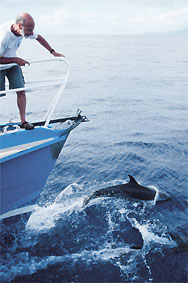 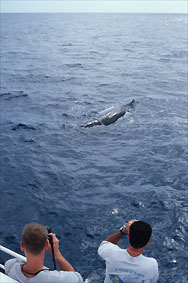 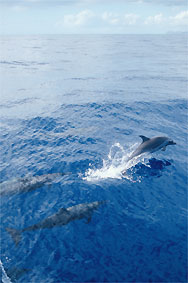
- Between november
and may, the chances of spoting cetacean on a three hour outing
are 90%.
|
- Engines off
as the camarers fire away when a nosy killer whale approaches
the Catadive.
|
- Playing on the
wave of the stem, the dolphins accompany the Catadive.
|
-
 To help the study, cencous and protection
of the turtles and cetacean of Guadeloupe : To help the study, cencous and protection
of the turtles and cetacean of Guadeloupe :
-
- As well as making a censous
of the whale population, the organization sets up night watches
on the beaches where turtles go to mate. They lend tents, lamps,
sleeping bags and various equipment... if your lucky enough you
might even get to witness one of these living dinosaurs lay an
eg.
-
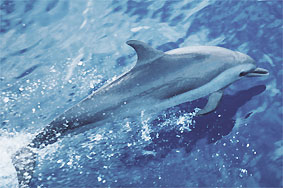 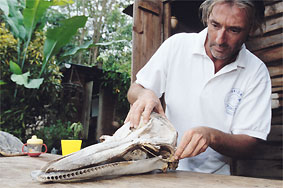
-
 Renato
Rinaldi - Association évasion tropicale. Renato
Rinaldi - Association évasion tropicale.
Courbaril 97125 Bouillante. Guadeloupe FWI
Tél. 0590.57.19.44. Fax. 0590.98.77.76. - evastropic@wanadoo.fr
-
-
-
 Dive in the Cousteau Nature Reserve Dive in the Cousteau Nature Reserve
-
- Learn to dive or explore
the beautifully preserved underwater sanctuary around the Pigeon
Isl
- ands in the enchanting Cousteau
reserve... without forgeting the impressive wreck of the Franjack,
now home to a multicolored fauna... Turtles, perrot fish, barracudas,
groupers...
-
 (click here to see the reportage) (click here to see the reportage)
-
- Spermwhale dolphins whale whale
watching,whale-watching whalewatching guadeloupe pics
- © Jean François
VIBERT - Journalist and photographer - Paris -
-
- Specialised in travels, extrems
sports, leisure activities, adventure trips, outdoor sports,
deserts and mountains... Trekking, ski, snowboard, mountain,
bike, sailing, scuba diving, hiking, in line skating... Texts
and pictures for the press and the web, illustration, digital
photography, reportages...
|
- Journaliste photographe - Spécialiste
des voyages, des sports de glisse, des loisirs, de l'aventure,
de l'outdoor, des déserts, des montagnes. VTT, trekking,
ski, snowboard, parapente, voile, plongée sous marine,
randonnées, roller in line... Textes et photos pour la
presse et internet, illustrations, photographie numérique,
reportages...
|
|

|
|
 Sperm whales, killer whales and dolphins
can be spotted just a few miles off the coast of the French island
Guadeloupe. This morning we've come across a twelve metre long
sperm whale. I slide into the water and swim towards him hoping
he doesn't dive...
Sperm whales, killer whales and dolphins
can be spotted just a few miles off the coast of the French island
Guadeloupe. This morning we've come across a twelve metre long
sperm whale. I slide into the water and swim towards him hoping
he doesn't dive...
 Listen
to the spermwhale
Listen
to the spermwhale
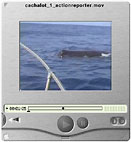
 The video of the spermwhale
The video of the spermwhale





 Listen
to the spermwhale
Listen
to the spermwhale













 Whasa
sperm whale ?
Whasa
sperm whale ?
 Listen
to the spermwhale
Listen
to the spermwhale


 The clash of the titans in the abyss
The clash of the titans in the abyss
 Sperm whales eats giant squeeds !
Sperm whales eats giant squeeds !
 And
why do whales dive so deep ? To feed on their favourite food,
giant squid (Architeuthis Dux). Traces of giant tenticles have
been found on some Sperm Whales which have led some scientists
to believe that some specimens living in the abyss can be tens
of meters in length.
And
why do whales dive so deep ? To feed on their favourite food,
giant squid (Architeuthis Dux). Traces of giant tenticles have
been found on some Sperm Whales which have led some scientists
to believe that some specimens living in the abyss can be tens
of meters in length.
 Divers
should be reasured, for they havn't a chance of ever coming face
to face with one of these monsters because of the deepth in which
they live. Down 1000 or 2000 metres, the abyss is as dark as
can be, temperatures are just above"0"and the pressure
is collossal, (this might explain why they are so rarely washed
up on shore : their invertibrated bodies don't stand up to the
change in pressure when they surface). Visit here the site of an American expidition
which tried (but failed) to film Architeuthis in 1999.
Divers
should be reasured, for they havn't a chance of ever coming face
to face with one of these monsters because of the deepth in which
they live. Down 1000 or 2000 metres, the abyss is as dark as
can be, temperatures are just above"0"and the pressure
is collossal, (this might explain why they are so rarely washed
up on shore : their invertibrated bodies don't stand up to the
change in pressure when they surface). Visit here the site of an American expidition
which tried (but failed) to film Architeuthis in 1999.
 You can go whale watching in Guadeloupe
You can go whale watching in Guadeloupe


 Centre de plongée Les
heures saines Réserve Cousteau
Centre de plongée Les
heures saines Réserve Cousteau Infos
voyage : Ultramarina (voyagiste plongée)
Infos
voyage : Ultramarina (voyagiste plongée)


 To help the study, cencous and protection
of the turtles and cetacean of Guadeloupe :
To help the study, cencous and protection
of the turtles and cetacean of Guadeloupe :


 Renato
Rinaldi - Association évasion tropicale.
Renato
Rinaldi - Association évasion tropicale. Humpback
whales (jubartes) in Samana Dominican Republic
Humpback
whales (jubartes) in Samana Dominican Republic
 Whale watching Cruise
Whale watching Cruise
 The road of whales in Quebec
The road of whales in Quebec
 Humpback whales of Samana Bay
Humpback whales of Samana Bay
 Dive in the Cousteau Nature Reserve
Dive in the Cousteau Nature Reserve
 (click here to see the reportage)
(click here to see the reportage)
